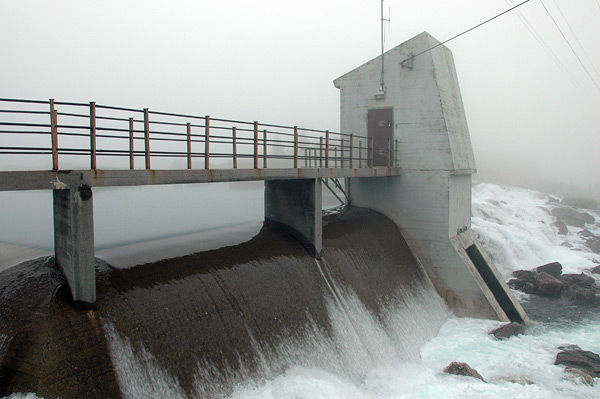
Hedging: Can a power company lose money on high electricity prices?
Norway has seen record high electricity prices in 2022, but on paper it can seem as if power producers are losing money. Why is this? The answer lies in the accounting rules for hedged power contracts. And no, the power producers are definitely not losing money on high prices.
Hallvard Granheim, Executive Vice President of Statkraft's business area Markets, wants to make it clear: "Statkraft is making money on high power prices. Most of our power production is sold at spot price and ensures that the company and its owners, the Norwegian state, profit from high prices."
In addition, the company enters into long-term financial contracts on electric power at a given price. Every quarter, the difference between the pre-agreed fixed price and the current spot price is recorded as a financial liability and recognised as a profit or loss in the company's accounts. With high spot prices, this could appear as if the company is losing money, and vice versa. It has to do with long-term hedging.
"Hedging is not gambling, as I've seen some claiming it to be. On the contrary. Hedging is a key element in the company's strategy. It's critical to our ability to enter into long-term power contracts with industrial companies, ensure that our public owners get predictable dividends, and secure revenues from our business activities. It would be irresponsible not to enter into such contracts," says Granheim.

Long-term predictability and security
In a weather-dependent power system like Norway’s, for example, electricity prices will normally vary widely. And in 2022, the war in Ukraine and the power scarcity in Europe have contributed to a historic and dramatic price hike in all energy sources.
To ensure a certain level of stability in cash flow and reduce risk, Statkraft sells a small share of its power production in advance, primarily by entering into long-term contracts with Norwegian industrial companies. These contracts also reduce risk for buyers of power in energy-intensive industries.
"Just as a fixed interest rate contract can mean lower interest expenses on a home loan in periods when floating interest rates shoot up, the pre-agreed power contracts work in such a way that electricity prices appear far too low when prices otherwise shoot up – as we have seen in 2022. Over time, however, the long-term contracts provide power producers and buyers alike with predictable conditions and lower risk," says Granheim.
Statkraft also sells a small amount of power in the financial power market several years in advance. It is these contracts that have inflicted significant unrealised accounting losses on the company in 2022. If this loss is viewed in isolation, however, it gives a misleading picture of the overall consequences for the company.
When a power producer sells power in advance, the company assumes a financial obligation. The company is required to report this obligation in their accounts every quarter. If the price of power has risen since the time when the pre-agreed contract was entered into, it will appear as a loss in the accounts, since the company is obliged to deliver power at a price lower than the market price, and thereby misses out on a larger profit than that secured through the advance sale.
When the value of each hedged pre-agreed contract is assessed every quarter, the full term of the contract is taken into account. This can be a matter of many years and, consequently, large amounts.

Hallvard Granheim
Hallvard Granheim is Executive Vice President for Statkraft's Markets business area.

About the Markets business area
The Markets business area is responsible for commercially optimising and developing Statkraft's flexible power generation portfolio.
Markets is also responsible for facilitating market access, supporting the company's investment decisions, and securing the company's long-term assets through global hedging strategies.
Earning money on all prices that are higher than the production cost
"To obtain a full picture of how the high electricity prices have affected Statkraft, it needs to be kept in mind that revenues from the ongoing production will increase. The high spot prices are reflected continuously in the accounts for unsecured production, but the future spot revenues are not recorded in the accounts," Granheim points out.
This is in compliance with the accounting rules with which Statkraft and large Norwegian companies comply, but it can easily give a skewed impression of the company's situation.
What is presented in the accounts as a loss is in practice an advance sale of power at a fixed price. In 2022 this fixed price has been lower than what could have achieved by selling the power at a later point in time, but it is nonetheless above Statkraft's production costs. So, the company also earns money on this part of the production.
When electricity prices drop below the contract price, advance sales of power will yield higher revenues because the price achieved is higher than if one had waited until the time of production.
Advance sales of power make power producers' revenues more predictable and thereby make planning easier. In 2022, Statkraft has earned lower revenues than it would have done if the company had not sold a share of its power in advance. But it is worth noting that such an advance sale made two years previously contributed to higher revenues at a time when electricity prices were extremely low.

Government risk guarantees?
The governments of Sweden, Finland and Denmark have provided enormous guarantees to ensure that critical power producers do not fail. Can they fail? Why hasn't the Norwegian state done likewise?
All companies on the Nasdaq power exchange must provide collateral according to the size of the contracts they enter into. When power prices go sky high, so do collateral requirements.
This collateral, called "margin requirements", must be made available at short notice, and entails a substantial liquidity risk in the form of a risk of increased costs in the event that a counterparty fails to settle its obligation on time. So even though financially sound power producers earn good money on power sales, the large collateral requirements can still create problems if risk is not properly managed.
The authorities in Sweden, Finland and Denmark have announced the introduction of guarantee schemes to avert power producers going bankrupt as a result of such margin requirements. The Norwegian Government sees no need to do likewise for the time being, but is monitoring the situation closely.
Hallvard Granheim understands the need for special measures in such extreme market situations as we have seen in 2002, but adds: "Statkraft is in a robust situation. We have sound financial management that enables us to cover our obligations. We don't need support from government schemes to manage our transactions in the market."
"One key reason for the difference in needs between Norwegian and other Nordic power producers is that in Norway we have a long tradition in long-term, physical power contracts that are entered into directly with industry, and that do not trigger such margin requirements," he explains.
Hedging is a key element in the company's strategy. It's critical to our ability to enter into long-term power contracts with industrial companies, ensure that our public owners get predictable dividends, and secure revenues from our business activities. It would be irresponsible not to enter into such contracts.
Physical and financial power markets: what are they?
-
Physical power trading involves the buying and selling of power where the power is delivered and payment settled according to the spot price. Plain and simple. The power market ensures efficient use of resources, secure supply, and that power is not more expensive than necessary.
-
Financial power trading involves the buying and selling of financial contracts that are used for risk management and hedging in the power market without physical delivery of power taking place. Financial power markets are nonetheless connected to the physical power markets in that settlement of financial power contracts are dependent on the spot price; in other words, on the price of physical power.
-
Financial power markets include trading with financial contracts that are used to manage risk on behalf of producers and consumers. For example, power customers use this to secure a predictable cost for a given period. It also offers opportunities for speculative trading. All contracts are settled financially, without any physical deliveries of power.
-
The advantage with financial power trading is that it makes it easier for industry to secure a future power price without setting up the infrastructure for selling and buying power physically. This means that, for example, investors in wind farms can secure future power prices financially with a counterparty at the same time as they agree physical management of the power with another counterparty. This requirement is often set by financing institutions when providing project finance to developers of renewable projects. In the same way, industry wants to attract investors and reduce risk by fixing the price of future power consumption in order to increase the likelihood of profitable operations.
-
Financial power trading can take place between two parties (bilaterally) or in a regulated marketplace. In the Nordic region, most of the financial trading is conducted on the Nasdaq power exchange.
-
Bilateral contracts can largely be tailored, and often do not require available capital in reserve should prices go up in the physical market.
Related Explained by Statkraft articles

Physical algorithmic trading: Quick decisions
With an ever-increasing share of renewable energy sources in the power grid, digital solutions for energy trading have become indispensable. Based on carefully developed algorithms, traders can op...
Read more

Financial algorithmic trading: Humans and machines join forces
In financial algorithmic trading, expectations of future trends in the energy market are bought and sold based on automated trading patterns. The interaction between machines and humans opens up...
Read more

Trading: Statkraft a major player in the power market
Statkraft is best known as a leading renewable energy producer and trader. Not everyone knows that the company is also a significant player in the European energy market.
Read more